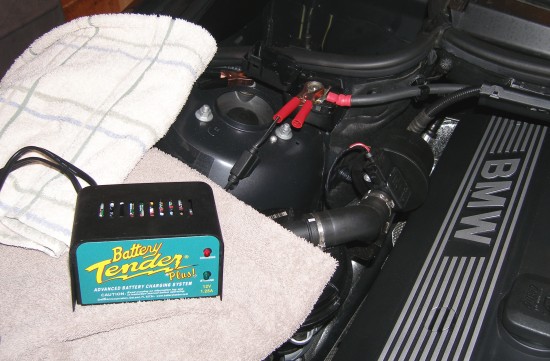January 28, 2007
Belated Year End Review
It's been six months since my last entry on the E46, but that's only because I haven't been driving it that much and it hasn't required any additional work (unlike the E36!). I've been driving it mostly on the weekends, but have had to call it to duty for the commute when the E36 was in the shop.
My overall opinion of the E46 ZHP really hasn't changed since purchase. It's a phenomenally built car (no rattles or squeaks) and a bunch of fun to drive. It's a great balance between the standard sport package E46 and the M3. I haven't done much driving with DSC off but the power is definitely there to make things exciting when it is.
The ZF transmission on this car is the closest you'll get to a manual without giving up the torque converter. I can drive this car just as aggressively as I would a stick or SMG car because unlike virtually every other auto, in manual mode the ZF transmission shifts NOW. Approaching a turn fast? Keep it straight and fast into the turn, brake hard, but smoothly, give the shift lever two blips forward to drop two gears as the car decelerates, turn in aggressively and apply power as you pass the apex. The power will be there, let me assure you. It's a ton of fun.
Some might argue (and under certain conditions I might agree) that the ZHP suspension is a bit overdamped. The effect is most apparent at 80+MPH when riding over the transitions from asphalt to concrete associated with bridge overpasses. If the transition is particularly abrupt, I feel like I'm driving a go-cart. It's not like my head hits the ceiling, but the car definitely gets skittish in the vertical plane.
 In this respect it's probably not unlike many
of the aftermarket suspension kits for this car that fail to achieve that beautiful
balance so typical of BMW's OE suspensions. But on all other surfaces, including
smooth highways, at 100+ the stability and smoothness of the car is awe inspiring.
The car begs to be driven on the track, but I won't be beating on it anytime
soon.
In this respect it's probably not unlike many
of the aftermarket suspension kits for this car that fail to achieve that beautiful
balance so typical of BMW's OE suspensions. But on all other surfaces, including
smooth highways, at 100+ the stability and smoothness of the car is awe inspiring.
The car begs to be driven on the track, but I won't be beating on it anytime
soon.
Anyway, on to the event that triggered this entry...
Good Voltage, Dead Battery
One evening a few weeks ago my brother and I were getting ready to coordinate the drop-off of his 2001 530i at my dealer so my tech could give it its first inspection (needless to say, it's a garage queen just like my E46 -- it doesn't get out much). My brother hopped in the car and turned the key, expecting to be rewarded with that oh-so-special sound of the BMW M54 firing up. Instead, the effort was met with a disconcerting loud clicking sound coming from somewhere near the left side of the engine and interior lights flashing in unison with the noises. When he released the key from the start position, all the interior lights and cluster indicators returned to normal, but multiple attempts to start the car failed.
We both instinctually assumed that the battery had died, but since I'm not one to give up so easily anymore when it comes to automotive diagnostics, I broke out my digital volt-ohm meter (VOM). Using the charging terminal in the engine bay I measured the current battery voltage at 12.0, which is typical of nearly fully discharged battery. We happened to have an old 10AMP battery charger on the shelf so we connected it and left it to do its thing for about three hours before trying again. The charging current had started near 10 AMPS but had tapered to about 4 amps over this period before I unplugged the charger and removed the clip leads from the car. Another quick voltage check revealed a steady 12.9V, so I figured we'd licked the problem.
This time I hopped in the car and turned the key, only to hear the familiar loud clicking noises and see the interior lights flashing. I sat puzzled. What could this be if not a dead battery? It was almost as if the car was doing its impression of a child and telling us in its own special way that it didn't want to go see the doctor. Needless to say, the parent often overrules the child, so my brother called AAA and had the car towed to the dealership, kicking and screaming.
My technician called me the following day. The diagnosis of a failed battery surprised me. I've dealt with my share of lead acid batteries, and the ones that have failed usually exhibited a lower voltage even when "fully charged". Here we had a battery that presented a full, healthy voltage but failed the most basic of load tests. That's when I learned voltage is not necessarily the best indicator as to the health of a lead acid battery.
Several Franklin's later (out of my brother's pocket -- not mine, fortunately), the car was returned to him with the inspection complete and a new battery installed. My technician assumed from the mileage that the car didn't drive very much and recommended my brother buy a charger and keep the battery topped off.
 Battery Research
Battery Research
This episode prompted me to do some research on battery chemistry, manufacturing technologies, and charging methods. Here's what I learned:
- The life of a car battery is most affected by heat. BMW got this one right. Not only does putting the battery in the trunk help with weight distribution and the vehicle's performance, it lowers the operating temperature of the battery and extends its life. This is one reason why it's not uncommon to hear of BMW batteries lasting seven years or longer in a daily driver.
- Batteries don't like to be deep cycled. The more times a battery is drawn down toward a fully discharged state, the shorter its life -- it's that simple. This is also true of so-called "deep cycle" batteries, though the internal design of deep cycle batteries helps mitigate the detrimental effects of deep cycling.
- Batteries typically fail due to a process called sulfation, which is the direct result of chemical processes made possible when a battery is less than fully charged. Thus, to keep a battery from undergoing sulfation, it must be kept fully charged at all times.
- Cars driven for short periods are more likely to have a battery fail prematurely than those driven for at least 15 minutes at highway speeds for each turn of the key. This is because the vehicle's charging system is designed to limit charging current, and if the car is not run long enough the battery will fail to reach a fully charged state. This will increase the risk of sulfation.
- Modern so-called "smart" battery chargers do their thing in three stages called "bulk", "absorption", and "float". Bulk charging occurs at a constant current typically equivalent to the charger's maximum rated current while the battery voltage is monitored. When the voltage reaches a predetermined limit based on the battery chemistry, the charger slowly tapers the charging current. This causes the voltage to increase more slowly as it rises toward the second predetermined limit, which represents the fully-charged state. When the voltage reaches that level the charger switches to float mode and pulses charging current at a low level only as necessary to keep the battery topped off.
- If you want to put a battery charger on your vehicle to keep its battery fully charged, you MUST use a smart charger. Older constant voltage chargers and other "trickle" chargers will destroy the battery by overcharging it and boiling off the electrolyte.
Based on this newfound knowledge I decided to invest in a battery charger for the E46. I wound up buying the 1.5A Battery Tender Plus model which is an updated version of the original Battery Tender that's rebranded by BMW and sold for twice the price. You read that right -- the BMW battery charger is nothing but a Battery Tender in disguise. If you're in the market for a "BMW approved" battery charger, do yourself a favor and pick up the Battery Tender Plus and pocket the $60 price differential.
Electrician for a Day
Of course, I would have done this earlier but the detached garage in which I store the E46 didn't have electricity until today. One of the few perks of being an electrician in a former life is that I can wire a garage for the cost of materials. It took me about six hours to run a wire from the adjacent garage over to mine, install a switch to control three fixtures equipped with energy saving compact flurorescent bulbs (150W equivalent, 42W actual) and several receptacles. At Vetter Electric Company's current rates, that's about $400 in labor I got for "free". I didn't really enjoy freezing my butt off outside, but what can I say -- there's nothing like saving money and having pride in one's work.
Mileage: 3280. Parts: $100, Tools & Equipment: $50, Labor Saved: $420.



